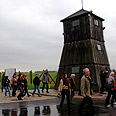
Swedish artist uses Shoah victims' ashes
Jewish community outraged by picture painted with ashes taken from Majdanek concentration camp's crematoria. 'I am sickened by his work and obsession with necrophilia,' leading community member says of artist Carl Michael von Hausswolff
According to the report, artist Carl Michael von Hausswolff mixed the ashes from the Nazi facility with water to compose a small painting of grey streaks, and his work is now on display in a gallery in the Swedish city of Lund.
The Telegraph reported that Salomon Schulman, a leading member of Sweden's Jewish community who lost many of his relatives in the Holocaust, had condemned the painting as "revolting."
Schulman wrote in a letter to a local newspaper, "Who knows, maybe some of the ashes originated from my relatives. No one knows where they were deported: All my mother's siblings and their children, and my grandparents… I am sickened by his work and obsession with necrophilia."
According to the Telegraph, Von Hausswolff took the ashes from Majdanek during a 1989 visit to the camp. He explained that the ashes appeared to "contain the memories and the souls of people: People tormented and murdered by other people in the most viscous war of the 20th Century."
The British newspaper reported that despite the scandal surrounding the painting, the Lund gallery owner Martin Bryder defended the decision to exhibit the work of art, telling the Polish News Agency, "Please come to the gallery, see the painting and judge for yourselves whether it's controversial."
Majdanek was a concentration and death camp established by the Nazis during World War II on the outskirts of the city of Lublin in Poland. The camp operated from October, 1941 until July, 1944. Its Jewish prisoners arrived from Czechoslovakia, Germany, Hungary, France, Belgium, Greece, Holland and Poland (including 10,000 prisoners after the Warsaw Ghetto Uprising).
Several underground movements were active in Majdanek, and attempts to escape the camp were carried out from time to time. On the eve of the camp's extermination, the Nazis had a plan to turn it into a sort of "Auschwitz 2," which would accommodate as many as 250,000 prisoners – five times its size at the time.
As Soviet forces rapidly approached Lublin in late July 1944, the Germans attempted to cover up the traces of murder and destroy the camp, but about one-quarter of the buildings were preserved.
In October 1944, the first commemoration site of Nazi camps was set up in Majdanek. Less than 10% of the camp's staff members were put on trial, and several were executed.
Some 500,000 people from 28 countries passed through Majdanek, and 360,000 of them perished – more than half were Jews. Some 60% of the victims died of hunger, illness and abuse, and the rest were murdered in the gas chambers or executed.










